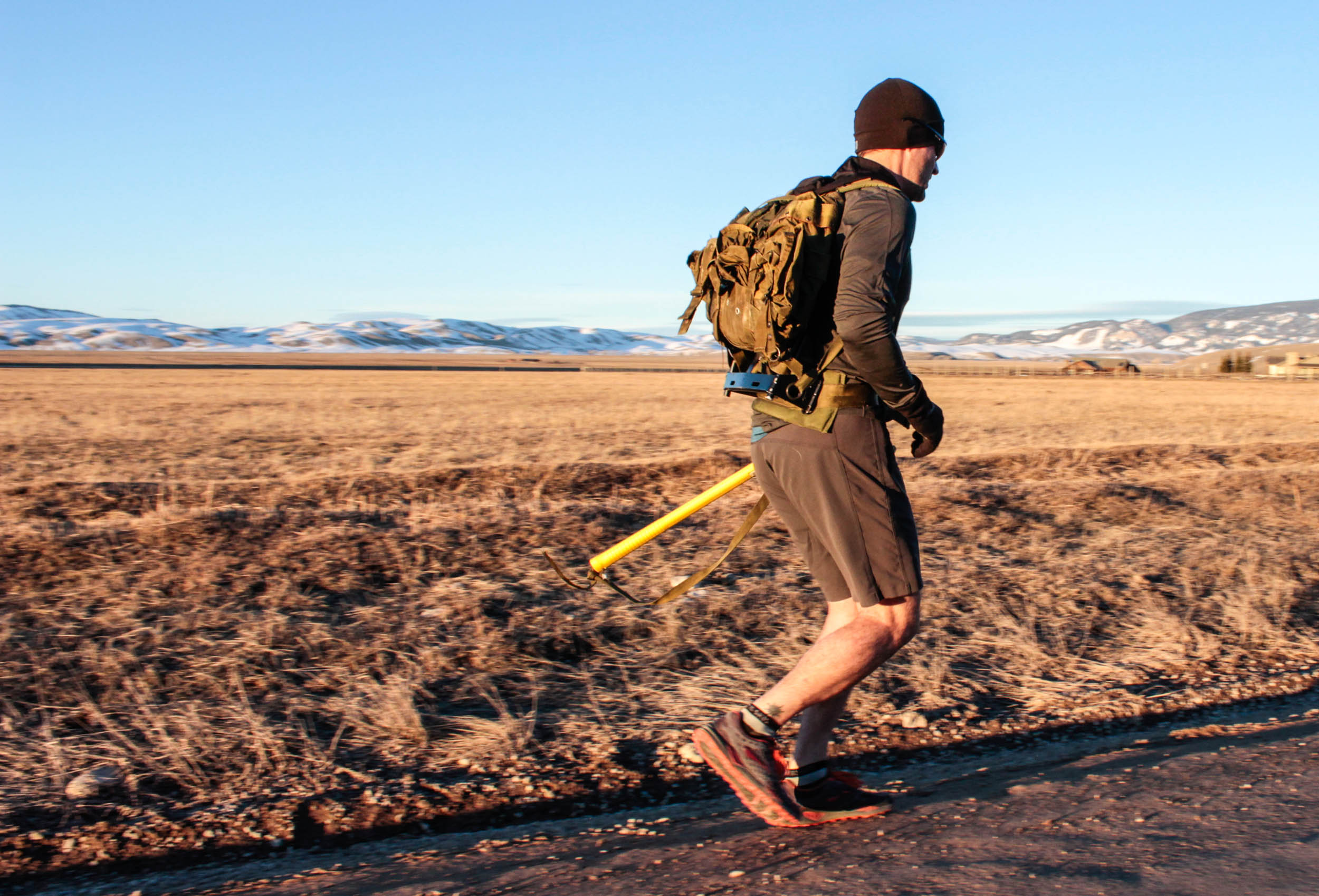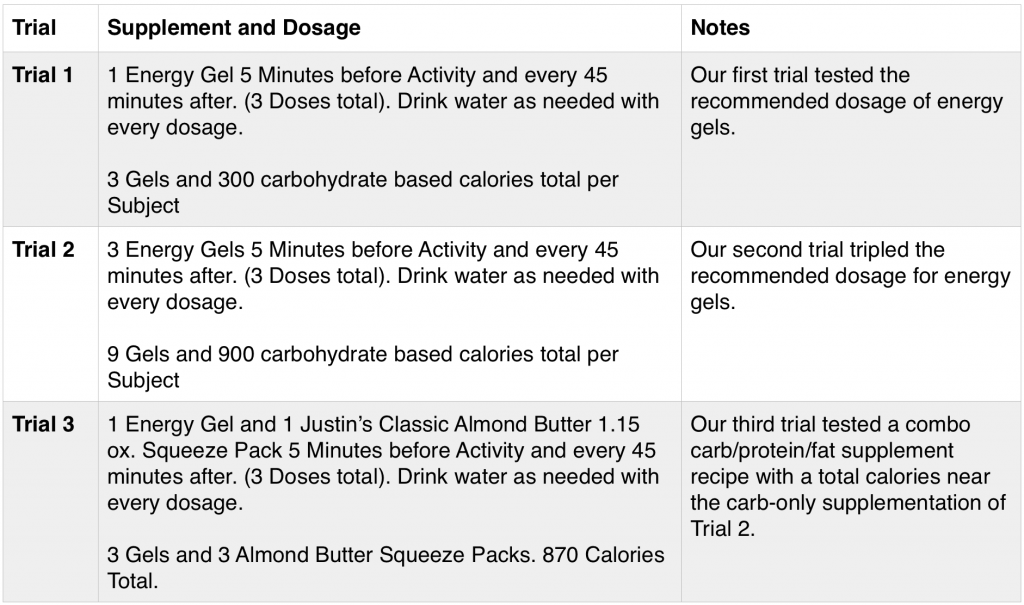
By Rob Shaul
BLUF
We conducted a mini-study to identify a recommended energy supplement dosage and/or recipe for extended loaded movement, but our results were inconclusive.
Background
Much research has been completed, and entire nutritional supplement companies created around developing optimal event nutrition for long, unloaded, endurance events such as ultramarathons, triathlons, and long road bike races.
However, in our review of existing research, we could find no research on the best performing event nutrition recipe and dosage for extended loaded movement.
First, a couple definitions.
By “event” nutrition we mean extended 2+ hour single mode or multimode events where the athlete is in some type of constant movement. Anecdotally and the research has proven, that nutritional supplementation during these long events improves performance.
With “Loaded Movement” we are referring to athletes whose sport or job requires them to carry backpacks/rucks and perhaps other equipment during these extended events. Few, if any, mountain and tactical athletes complete extended movement as part of their sport or work without carrying some type of pack/ruck with extra clothing, safety equipment, bivy gear, weapons/ammo, etc.
Anecdotally, we can feel that loaded movement at the same speed as unloaded movement demands higher muscular demand and cardiovascular rate. MTI has completed another mini-study on uphill movement which found that loaded movement increased caloric demand by 50%.
The most commonly used type of unloaded endurance event nutritional supplement is the energy gel. Multiple companies manufacture and sell carbohydrate-based energy gels including GU Energy, Hammer Nutrition, Clif Bar, and Honey Stinger. The recommended dosage for these gel products is 1 gel 5 minutes before, and then every 45 minutes for a long, unloaded, event such as a long trail run, bike ride, triathlon, etc.
The hypothesis of this mini-study was that because loaded movement demands a higher caloric and muscular demand, a higher carbohydrate dosage and/or a combo carb/fat/protein event nutrition supplement would perform better than 1 gel per 45 minutes recommended dosage for unloaded movement.
The “better answer” we hoped to provide mountain and tactical athletes with following the study is a research-driven recommended dosage and/or recipe for extended loaded events.
Study Design/Deployment
A small, quick mini-study is a great tool for us to accomplish several things before conducting a larger, longer, more involved study. First, we test the practicality and “churn” the testing protocols in the study. Second, mini study results can help us quickly identify obvious paths to follow with further research. Mini Studies are the primary tool we deploy for MTI’s Mission Direct Research.
The “mission-direct” emphasis of MTI’s research significantly impacts study design. Ideally, our mini-studies deploy elements that are practical and commonly used/experienced by our mountain and tactical athlete population. As well, ideally, our mini studies are simple enough that the same study can be completed by others, without special equipment, techniques, or expertise.
We worked closely with Roxanne Vogel, Sports Nutritionist at GU Energy, in developing the design for this mini-study. We had three questions going into the study design:
Question 1: What would be the nutrition supplement dosage and recipe variations?
To keep things simple we decided to use common, non-caffeinated energy gels and almond butter as our event nutrition supplements and conduct three trials.
With this mini-study, we wanted to test the effect of a supplement recipe that includes carbs, fat, and protein. To keep this simple, we decide on nut butter, and to keep it even simpler, decided to use Justin’s brand, Classic Almond Butter Squeeze Packs as we felt these could easily be carried and eaten by mountain and tactical athletes during loaded movement. Each 1.15 oz. squeeze pack contains a total of 190 calories with 160 calories from fat. Each pack contains 6g of carbs, 7g of protein, and 18g of fat.

Question 2: How would the event be designed to ensure the same amount of work was completed for every trial and how long should the event last?
We had two choices for event design: (1) loaded single mode, extended effort – either a ruck or step ups, at a specific pace, or; (2) loaded gym-based endurance effort. We went with (2) to facilitate completing the work inside and managing the nutrition feeding times and process.
I designed 3 separate gym-based endurance circuits which would be completed wearing a 25# weight vest. Each circuit would go for 45 minutes (135 min total work), with a break between to ingest the supplement.
To ensure the same work was done for each trial, I designed the circuits so each exercise would be completed for 3 minutes, and dictated how many reps of each exercise were to be completed in this duration. Below is the final design completed by the lab rats and supplementation schedule. As well, we mandated a 10 hour fast for each lab rat before each trial.
Events …. 3 Min Circuits, 5 Rounds, all wearing 25# Vest
****5 Min Before – Eat Energy Supplement
Circuit 1: 45 min
5 Rounds, 3 Min Each …
– 4x SB Pick Up & Carry @ 60#
– 20x 1-Arm KB Snatch @ 16kg
– 60x Step Ups @ 17″
****Eat Supplement between circuits
Circuit 2: 45 min
5 Rounds, 3 Min Each …
– 20x Sandbag Getup @ 40#
– 40x Keg Lift @ 40#
– 60x Step Ups @ 17″
****Supplement between circuits
Circuit 3: 45 min
5 Rounds, 3 Min Each …
– 20x Power Clean + Push Press @ 75#
– 5x Sandbag Clean & Run @ 60#
– 60x Step Ups @ 17″
Question 3: How would the nutrition supplementation for each trial be tested?
A previous study on event supplementation involved road cyclists who completed a 2 hour road constant load road cycle followed by a 20-minute max effort time trial. The “test” for the supplementation performance was the time trial finish distance. The further the finish distance in 20 minutes, the better the nutrition supplement performed.
We deployed the same methodology for this study. Our assessment was a 90 second, unloaded, 40-foot shuttle for reps, directly after completing the final gym-based endurance circuit. We assumed this short, hard, event would assess how much each lab rat had “left in the tank” at the end of the gym-based endurance event. A higher number of 40-foot shuttle reps would identify which supplementation was most effective.
Results/Discussion
Three veteran MTI Athletes (myself included) served as study subjects and completed the study trials over the course of 3 days. Each lab rat wore a Suunto Ambit 3 fitness watch and heart rate band to measure the total caloric burn for each trial. The results are below.

This mini-study “test” of supplementation performance was the number of shuttle run reps completed after the 135 minutes of gym-based endurance. The idea was this event would test what was “left in the tank” for each athlete and thereby identify which supplementation dosage/recipe was most effective.
However, there was no significant difference in shuttle reps completed between trials.
Why not? Most obvious answer is a flaw in the study design. Specifically, either the gym-based endurance event was not long enough to take the subject to nutritional depletion, and/or the 90-second shuttle sprint duration at the conclusion was too short to identify a difference in supplement performance. Perhaps the test event – 40-foot shuttle reps – was poor choice to assess nutrition performance, or we should have extended the test time to 5 or 10 minutes.
Perhaps another reason no significant difference was seen is that the body can only absorb so many calories per hour, thus the extra supplementation in Trials 2 and 3, though consumed, could not be absorbed and used by the body for fuel. During the study research, we found a wide variation of answers and recommendations to this question with most ranging between 100 and 300 calories absorbed per hour. Complicating this is that individual athlete size and weight, and supplement form (liquid, solid or gel) all make a difference and how many calories are absorbed.
Finally, we did not complete a trial without supplementation. Doing so we’d expect to see decreased performance in the shuttle rep performance. However, because this trial was not completed, we’re not sure how much, if any drop, there would be.
Next Steps?
The lack of any concrete results from this mini-study leaves us somewhat at a loss on how to proceed next. Here are some initial thoughts:
– Perhaps we could re-complete the study with extended loaded movement duration beyond the 2.25 hours we did complete to ensure nutritional depletion. Anecdotally I can report that this overall event was no joke – and I doubt few of our other lab rats could have completed it. The muscular hit to the tactical chassis (legs and core) was significant
– Perhaps we could repeat the trials (40 foot shuttles for reps), but extend the final assessment to 5 or 10 minutes. This perhaps is the most obvious change. Anecdotally, I can report the 90 second effort was not easy, and going much longer would have turned the shuttle sprints into shuttle slogs – but perhaps this would better assess the remaining “fuel in the tank” for each athlete and thus, the effectiveness of the nutritional strategies.
– Perhaps we could complete a single mode extended event (ruck) rather than a gym-based, multi-mode event. A 2.5 hour ruck would have likely been easier.
– Perhaps we could change the supplementation recipe and form being tested – liquid over gels, for example. We had considered, this, but the manufactured recommended liquid consumption for several of the existing energy shake mixes were beyond what we could have reasonably consumed during the trials.
Questions, Feedback, Comments? Email coach@mtntactical.com
You Might Also Like MTI’s Rucking Improvement Plan
